GEN110 Essay: Queer Theory, Gender, and Heterosexual Reproduction
VerifiedAdded on 2022/11/17
|8
|2144
|453
Essay
AI Summary
This essay explores queer theory, gender, and heterosexual reproduction. It begins by defining queer theory and its relationship to gender and heterosexual studies, including discussions on gender identity, gender roles, and the societal impact of gender constructs. The essay examines the queer theory's approach to sexuality and gender, including the concepts of gender identity, gender expression, biological sex, and sexual orientation, and their interplay within the 'gender-bread person' framework. It highlights the theory's challenges to societal norms and the concept of heteronormativity. The essay further analyzes the cross-cultural perspectives on gender and sexuality, the roles individuals play in society, and the challenges the queer community faces. It concludes with a discussion on the importance of challenging societal viewpoints and the future implications of queerness. The essay uses supporting references from academic sources.
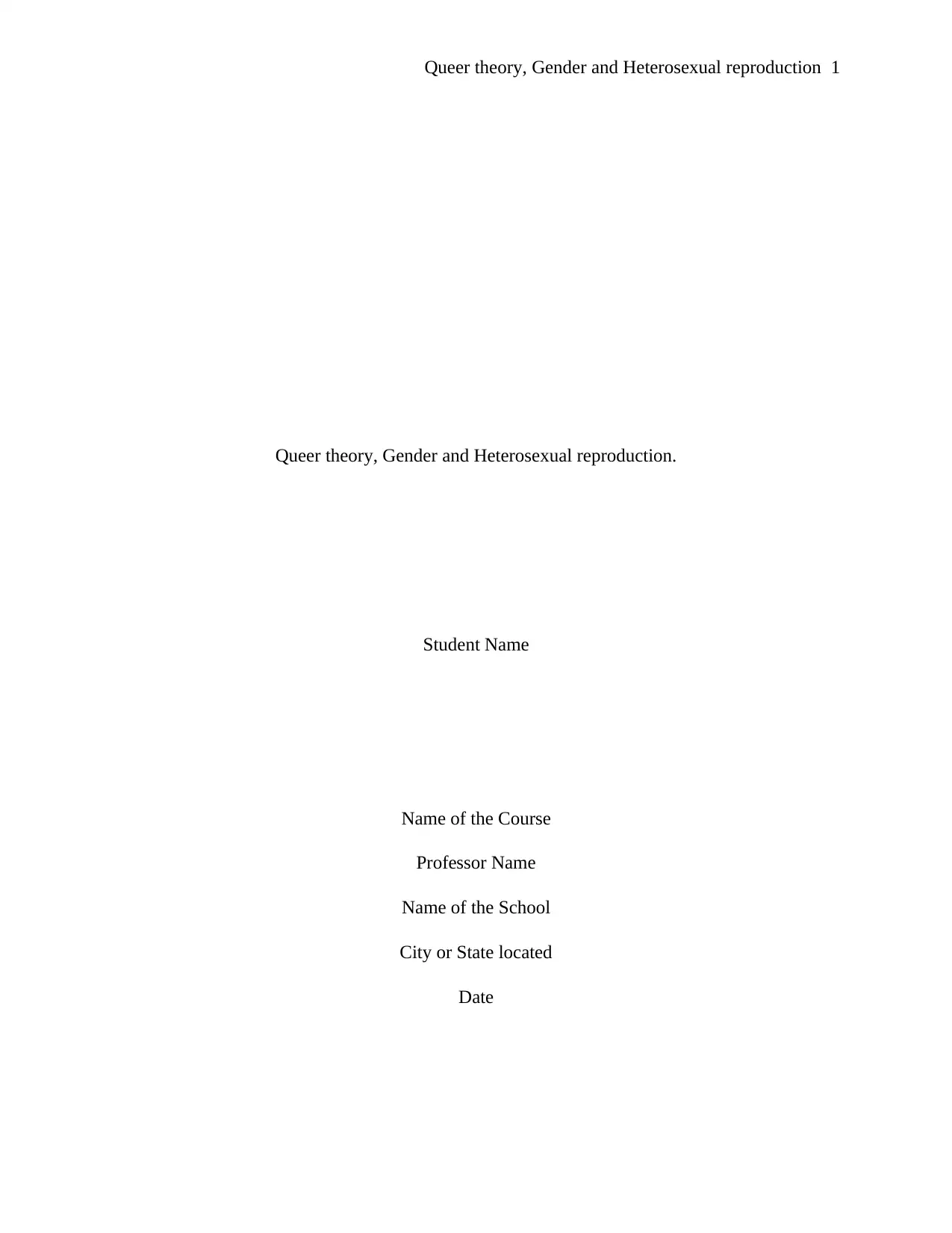
Queer theory, Gender and Heterosexual reproduction 1
Queer theory, Gender and Heterosexual reproduction.
Student Name
Name of the Course
Professor Name
Name of the School
City or State located
Date
Queer theory, Gender and Heterosexual reproduction.
Student Name
Name of the Course
Professor Name
Name of the School
City or State located
Date
Paraphrase This Document
Need a fresh take? Get an instant paraphrase of this document with our AI Paraphraser
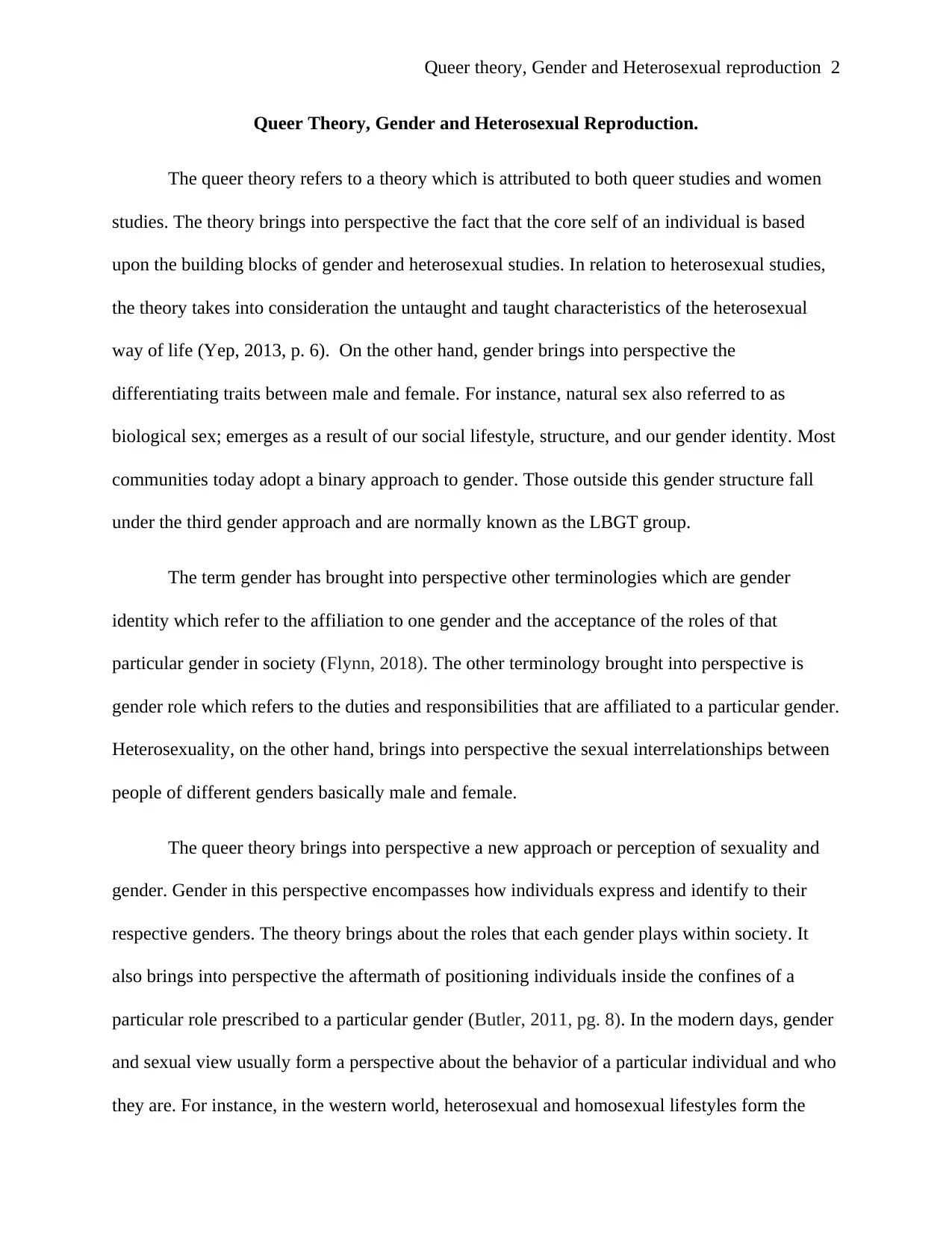
Queer theory, Gender and Heterosexual reproduction 2
Queer Theory, Gender and Heterosexual Reproduction.
The queer theory refers to a theory which is attributed to both queer studies and women
studies. The theory brings into perspective the fact that the core self of an individual is based
upon the building blocks of gender and heterosexual studies. In relation to heterosexual studies,
the theory takes into consideration the untaught and taught characteristics of the heterosexual
way of life (Yep, 2013, p. 6). On the other hand, gender brings into perspective the
differentiating traits between male and female. For instance, natural sex also referred to as
biological sex; emerges as a result of our social lifestyle, structure, and our gender identity. Most
communities today adopt a binary approach to gender. Those outside this gender structure fall
under the third gender approach and are normally known as the LBGT group.
The term gender has brought into perspective other terminologies which are gender
identity which refer to the affiliation to one gender and the acceptance of the roles of that
particular gender in society (Flynn, 2018). The other terminology brought into perspective is
gender role which refers to the duties and responsibilities that are affiliated to a particular gender.
Heterosexuality, on the other hand, brings into perspective the sexual interrelationships between
people of different genders basically male and female.
The queer theory brings into perspective a new approach or perception of sexuality and
gender. Gender in this perspective encompasses how individuals express and identify to their
respective genders. The theory brings about the roles that each gender plays within society. It
also brings into perspective the aftermath of positioning individuals inside the confines of a
particular role prescribed to a particular gender (Butler, 2011, pg. 8). In the modern days, gender
and sexual view usually form a perspective about the behavior of a particular individual and who
they are. For instance, in the western world, heterosexual and homosexual lifestyles form the
Queer Theory, Gender and Heterosexual Reproduction.
The queer theory refers to a theory which is attributed to both queer studies and women
studies. The theory brings into perspective the fact that the core self of an individual is based
upon the building blocks of gender and heterosexual studies. In relation to heterosexual studies,
the theory takes into consideration the untaught and taught characteristics of the heterosexual
way of life (Yep, 2013, p. 6). On the other hand, gender brings into perspective the
differentiating traits between male and female. For instance, natural sex also referred to as
biological sex; emerges as a result of our social lifestyle, structure, and our gender identity. Most
communities today adopt a binary approach to gender. Those outside this gender structure fall
under the third gender approach and are normally known as the LBGT group.
The term gender has brought into perspective other terminologies which are gender
identity which refer to the affiliation to one gender and the acceptance of the roles of that
particular gender in society (Flynn, 2018). The other terminology brought into perspective is
gender role which refers to the duties and responsibilities that are affiliated to a particular gender.
Heterosexuality, on the other hand, brings into perspective the sexual interrelationships between
people of different genders basically male and female.
The queer theory brings into perspective a new approach or perception of sexuality and
gender. Gender in this perspective encompasses how individuals express and identify to their
respective genders. The theory brings about the roles that each gender plays within society. It
also brings into perspective the aftermath of positioning individuals inside the confines of a
particular role prescribed to a particular gender (Butler, 2011, pg. 8). In the modern days, gender
and sexual view usually form a perspective about the behavior of a particular individual and who
they are. For instance, in the western world, heterosexual and homosexual lifestyles form the
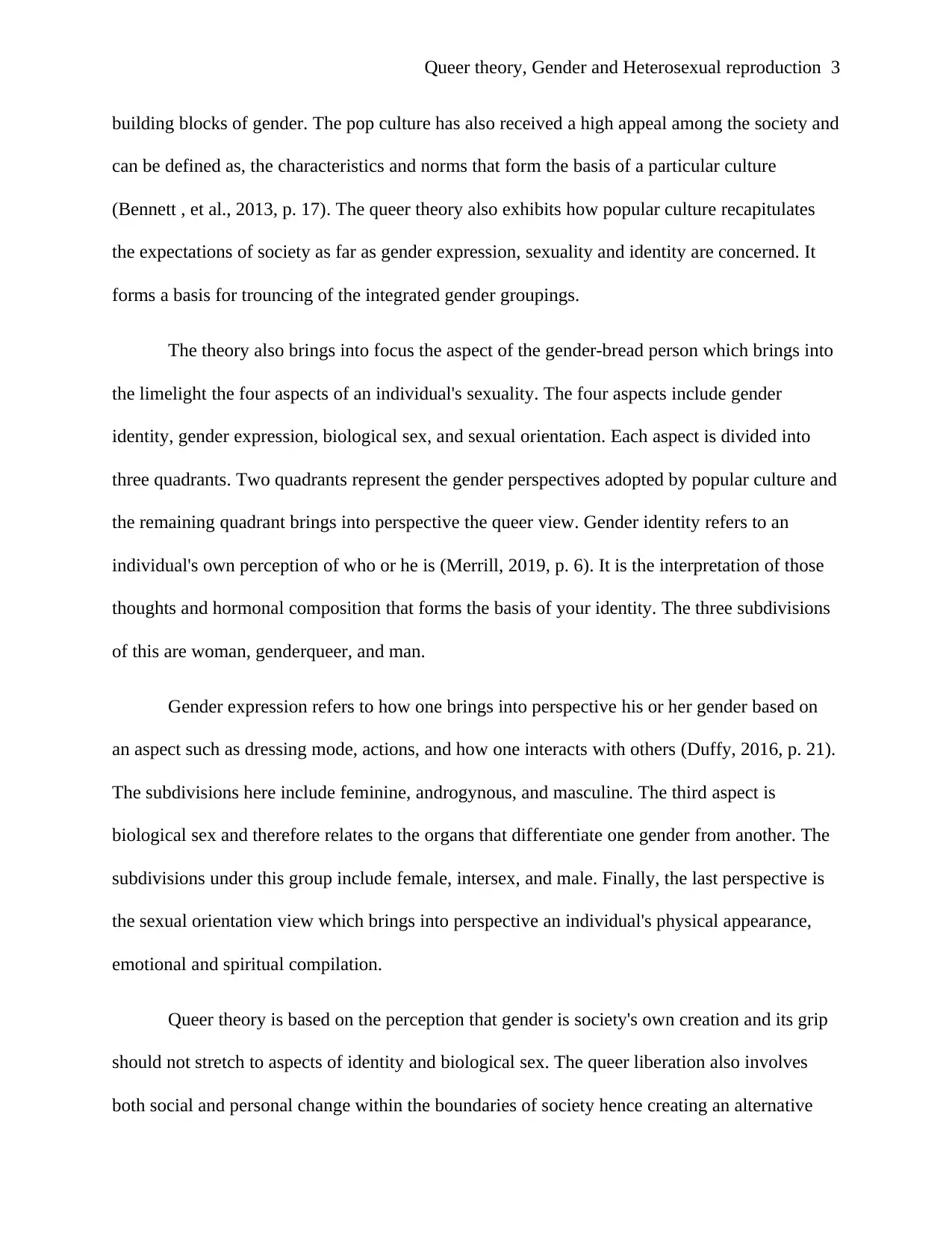
Queer theory, Gender and Heterosexual reproduction 3
building blocks of gender. The pop culture has also received a high appeal among the society and
can be defined as, the characteristics and norms that form the basis of a particular culture
(Bennett , et al., 2013, p. 17). The queer theory also exhibits how popular culture recapitulates
the expectations of society as far as gender expression, sexuality and identity are concerned. It
forms a basis for trouncing of the integrated gender groupings.
The theory also brings into focus the aspect of the gender-bread person which brings into
the limelight the four aspects of an individual's sexuality. The four aspects include gender
identity, gender expression, biological sex, and sexual orientation. Each aspect is divided into
three quadrants. Two quadrants represent the gender perspectives adopted by popular culture and
the remaining quadrant brings into perspective the queer view. Gender identity refers to an
individual's own perception of who or he is (Merrill, 2019, p. 6). It is the interpretation of those
thoughts and hormonal composition that forms the basis of your identity. The three subdivisions
of this are woman, genderqueer, and man.
Gender expression refers to how one brings into perspective his or her gender based on
an aspect such as dressing mode, actions, and how one interacts with others (Duffy, 2016, p. 21).
The subdivisions here include feminine, androgynous, and masculine. The third aspect is
biological sex and therefore relates to the organs that differentiate one gender from another. The
subdivisions under this group include female, intersex, and male. Finally, the last perspective is
the sexual orientation view which brings into perspective an individual's physical appearance,
emotional and spiritual compilation.
Queer theory is based on the perception that gender is society's own creation and its grip
should not stretch to aspects of identity and biological sex. The queer liberation also involves
both social and personal change within the boundaries of society hence creating an alternative
building blocks of gender. The pop culture has also received a high appeal among the society and
can be defined as, the characteristics and norms that form the basis of a particular culture
(Bennett , et al., 2013, p. 17). The queer theory also exhibits how popular culture recapitulates
the expectations of society as far as gender expression, sexuality and identity are concerned. It
forms a basis for trouncing of the integrated gender groupings.
The theory also brings into focus the aspect of the gender-bread person which brings into
the limelight the four aspects of an individual's sexuality. The four aspects include gender
identity, gender expression, biological sex, and sexual orientation. Each aspect is divided into
three quadrants. Two quadrants represent the gender perspectives adopted by popular culture and
the remaining quadrant brings into perspective the queer view. Gender identity refers to an
individual's own perception of who or he is (Merrill, 2019, p. 6). It is the interpretation of those
thoughts and hormonal composition that forms the basis of your identity. The three subdivisions
of this are woman, genderqueer, and man.
Gender expression refers to how one brings into perspective his or her gender based on
an aspect such as dressing mode, actions, and how one interacts with others (Duffy, 2016, p. 21).
The subdivisions here include feminine, androgynous, and masculine. The third aspect is
biological sex and therefore relates to the organs that differentiate one gender from another. The
subdivisions under this group include female, intersex, and male. Finally, the last perspective is
the sexual orientation view which brings into perspective an individual's physical appearance,
emotional and spiritual compilation.
Queer theory is based on the perception that gender is society's own creation and its grip
should not stretch to aspects of identity and biological sex. The queer liberation also involves
both social and personal change within the boundaries of society hence creating an alternative
⊘ This is a preview!⊘
Do you want full access?
Subscribe today to unlock all pages.

Trusted by 1+ million students worldwide
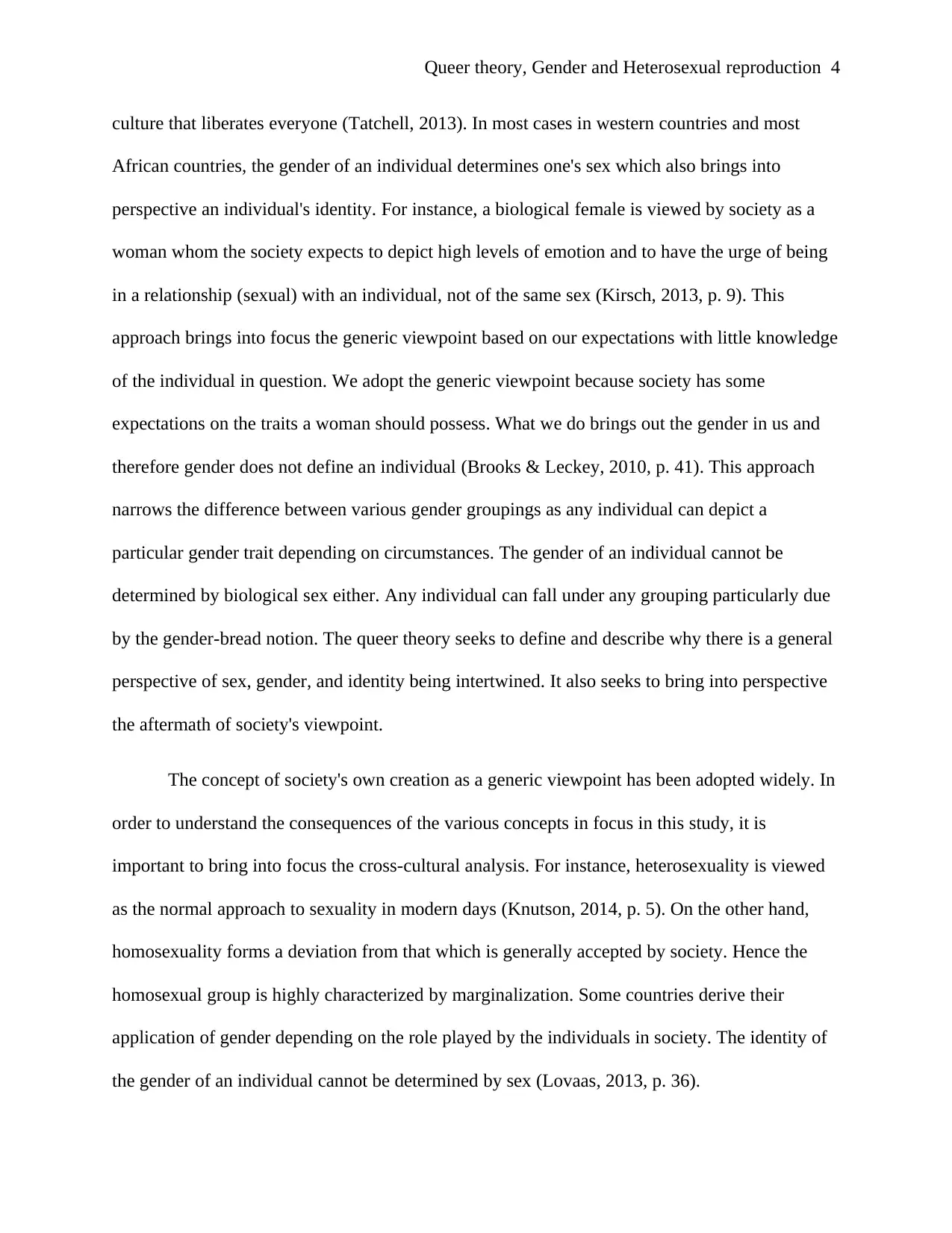
Queer theory, Gender and Heterosexual reproduction 4
culture that liberates everyone (Tatchell, 2013). In most cases in western countries and most
African countries, the gender of an individual determines one's sex which also brings into
perspective an individual's identity. For instance, a biological female is viewed by society as a
woman whom the society expects to depict high levels of emotion and to have the urge of being
in a relationship (sexual) with an individual, not of the same sex (Kirsch, 2013, p. 9). This
approach brings into focus the generic viewpoint based on our expectations with little knowledge
of the individual in question. We adopt the generic viewpoint because society has some
expectations on the traits a woman should possess. What we do brings out the gender in us and
therefore gender does not define an individual (Brooks & Leckey, 2010, p. 41). This approach
narrows the difference between various gender groupings as any individual can depict a
particular gender trait depending on circumstances. The gender of an individual cannot be
determined by biological sex either. Any individual can fall under any grouping particularly due
by the gender-bread notion. The queer theory seeks to define and describe why there is a general
perspective of sex, gender, and identity being intertwined. It also seeks to bring into perspective
the aftermath of society's viewpoint.
The concept of society's own creation as a generic viewpoint has been adopted widely. In
order to understand the consequences of the various concepts in focus in this study, it is
important to bring into focus the cross-cultural analysis. For instance, heterosexuality is viewed
as the normal approach to sexuality in modern days (Knutson, 2014, p. 5). On the other hand,
homosexuality forms a deviation from that which is generally accepted by society. Hence the
homosexual group is highly characterized by marginalization. Some countries derive their
application of gender depending on the role played by the individuals in society. The identity of
the gender of an individual cannot be determined by sex (Lovaas, 2013, p. 36).
culture that liberates everyone (Tatchell, 2013). In most cases in western countries and most
African countries, the gender of an individual determines one's sex which also brings into
perspective an individual's identity. For instance, a biological female is viewed by society as a
woman whom the society expects to depict high levels of emotion and to have the urge of being
in a relationship (sexual) with an individual, not of the same sex (Kirsch, 2013, p. 9). This
approach brings into focus the generic viewpoint based on our expectations with little knowledge
of the individual in question. We adopt the generic viewpoint because society has some
expectations on the traits a woman should possess. What we do brings out the gender in us and
therefore gender does not define an individual (Brooks & Leckey, 2010, p. 41). This approach
narrows the difference between various gender groupings as any individual can depict a
particular gender trait depending on circumstances. The gender of an individual cannot be
determined by biological sex either. Any individual can fall under any grouping particularly due
by the gender-bread notion. The queer theory seeks to define and describe why there is a general
perspective of sex, gender, and identity being intertwined. It also seeks to bring into perspective
the aftermath of society's viewpoint.
The concept of society's own creation as a generic viewpoint has been adopted widely. In
order to understand the consequences of the various concepts in focus in this study, it is
important to bring into focus the cross-cultural analysis. For instance, heterosexuality is viewed
as the normal approach to sexuality in modern days (Knutson, 2014, p. 5). On the other hand,
homosexuality forms a deviation from that which is generally accepted by society. Hence the
homosexual group is highly characterized by marginalization. Some countries derive their
application of gender depending on the role played by the individuals in society. The identity of
the gender of an individual cannot be determined by sex (Lovaas, 2013, p. 36).
Paraphrase This Document
Need a fresh take? Get an instant paraphrase of this document with our AI Paraphraser
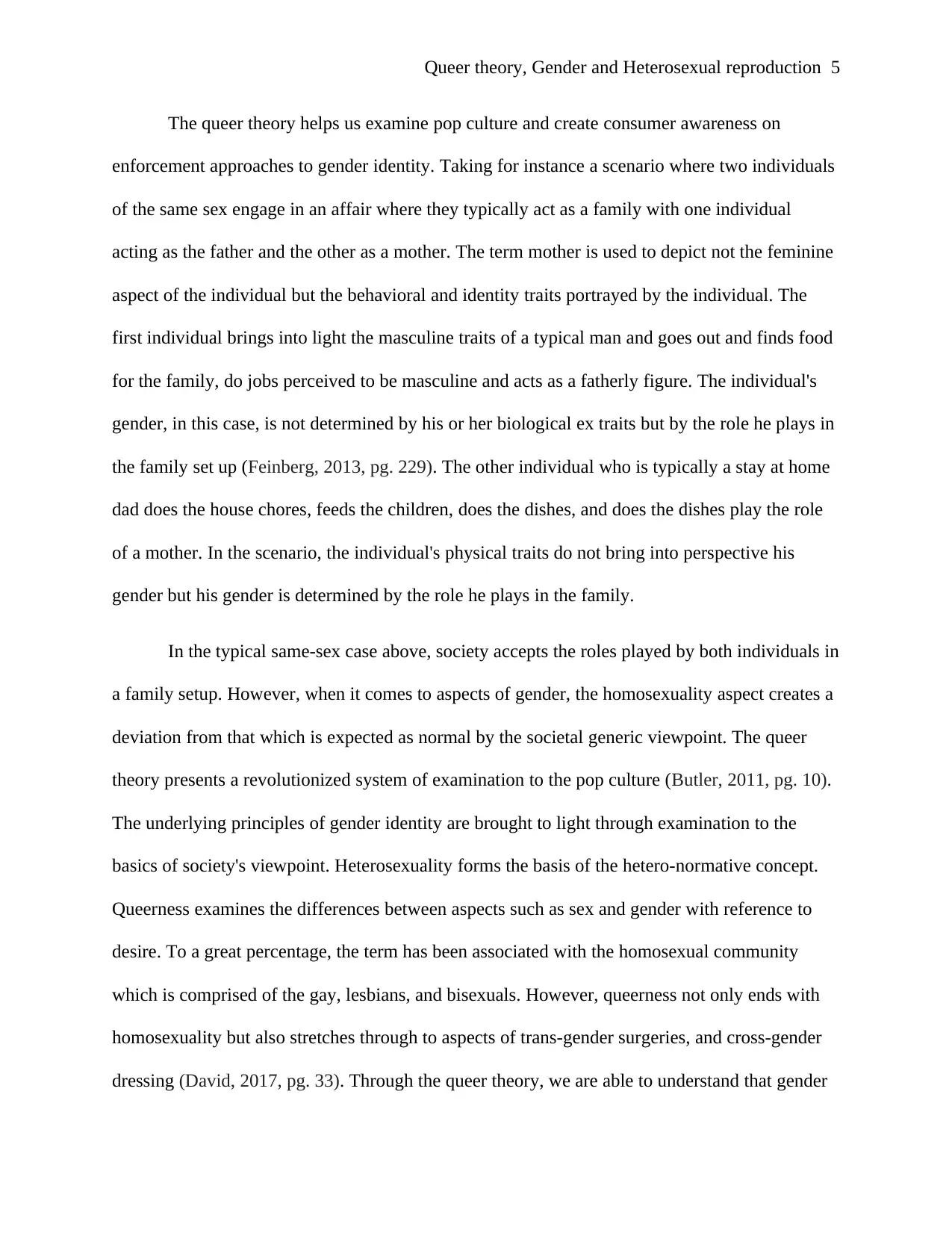
Queer theory, Gender and Heterosexual reproduction 5
The queer theory helps us examine pop culture and create consumer awareness on
enforcement approaches to gender identity. Taking for instance a scenario where two individuals
of the same sex engage in an affair where they typically act as a family with one individual
acting as the father and the other as a mother. The term mother is used to depict not the feminine
aspect of the individual but the behavioral and identity traits portrayed by the individual. The
first individual brings into light the masculine traits of a typical man and goes out and finds food
for the family, do jobs perceived to be masculine and acts as a fatherly figure. The individual's
gender, in this case, is not determined by his or her biological ex traits but by the role he plays in
the family set up (Feinberg, 2013, pg. 229). The other individual who is typically a stay at home
dad does the house chores, feeds the children, does the dishes, and does the dishes play the role
of a mother. In the scenario, the individual's physical traits do not bring into perspective his
gender but his gender is determined by the role he plays in the family.
In the typical same-sex case above, society accepts the roles played by both individuals in
a family setup. However, when it comes to aspects of gender, the homosexuality aspect creates a
deviation from that which is expected as normal by the societal generic viewpoint. The queer
theory presents a revolutionized system of examination to the pop culture (Butler, 2011, pg. 10).
The underlying principles of gender identity are brought to light through examination to the
basics of society's viewpoint. Heterosexuality forms the basis of the hetero-normative concept.
Queerness examines the differences between aspects such as sex and gender with reference to
desire. To a great percentage, the term has been associated with the homosexual community
which is comprised of the gay, lesbians, and bisexuals. However, queerness not only ends with
homosexuality but also stretches through to aspects of trans-gender surgeries, and cross-gender
dressing (David, 2017, pg. 33). Through the queer theory, we are able to understand that gender
The queer theory helps us examine pop culture and create consumer awareness on
enforcement approaches to gender identity. Taking for instance a scenario where two individuals
of the same sex engage in an affair where they typically act as a family with one individual
acting as the father and the other as a mother. The term mother is used to depict not the feminine
aspect of the individual but the behavioral and identity traits portrayed by the individual. The
first individual brings into light the masculine traits of a typical man and goes out and finds food
for the family, do jobs perceived to be masculine and acts as a fatherly figure. The individual's
gender, in this case, is not determined by his or her biological ex traits but by the role he plays in
the family set up (Feinberg, 2013, pg. 229). The other individual who is typically a stay at home
dad does the house chores, feeds the children, does the dishes, and does the dishes play the role
of a mother. In the scenario, the individual's physical traits do not bring into perspective his
gender but his gender is determined by the role he plays in the family.
In the typical same-sex case above, society accepts the roles played by both individuals in
a family setup. However, when it comes to aspects of gender, the homosexuality aspect creates a
deviation from that which is expected as normal by the societal generic viewpoint. The queer
theory presents a revolutionized system of examination to the pop culture (Butler, 2011, pg. 10).
The underlying principles of gender identity are brought to light through examination to the
basics of society's viewpoint. Heterosexuality forms the basis of the hetero-normative concept.
Queerness examines the differences between aspects such as sex and gender with reference to
desire. To a great percentage, the term has been associated with the homosexual community
which is comprised of the gay, lesbians, and bisexuals. However, queerness not only ends with
homosexuality but also stretches through to aspects of trans-gender surgeries, and cross-gender
dressing (David, 2017, pg. 33). Through the queer theory, we are able to understand that gender
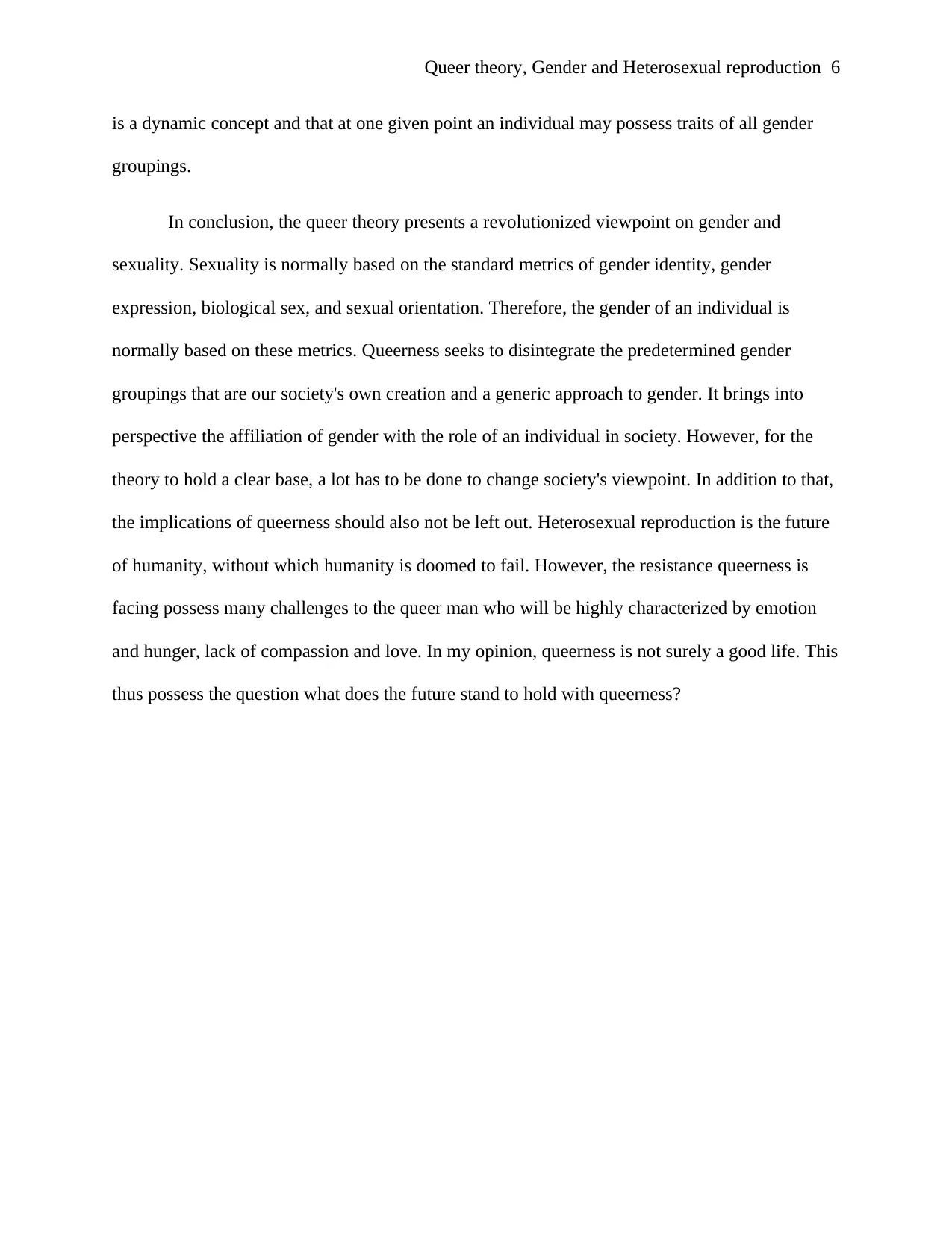
Queer theory, Gender and Heterosexual reproduction 6
is a dynamic concept and that at one given point an individual may possess traits of all gender
groupings.
In conclusion, the queer theory presents a revolutionized viewpoint on gender and
sexuality. Sexuality is normally based on the standard metrics of gender identity, gender
expression, biological sex, and sexual orientation. Therefore, the gender of an individual is
normally based on these metrics. Queerness seeks to disintegrate the predetermined gender
groupings that are our society's own creation and a generic approach to gender. It brings into
perspective the affiliation of gender with the role of an individual in society. However, for the
theory to hold a clear base, a lot has to be done to change society's viewpoint. In addition to that,
the implications of queerness should also not be left out. Heterosexual reproduction is the future
of humanity, without which humanity is doomed to fail. However, the resistance queerness is
facing possess many challenges to the queer man who will be highly characterized by emotion
and hunger, lack of compassion and love. In my opinion, queerness is not surely a good life. This
thus possess the question what does the future stand to hold with queerness?
is a dynamic concept and that at one given point an individual may possess traits of all gender
groupings.
In conclusion, the queer theory presents a revolutionized viewpoint on gender and
sexuality. Sexuality is normally based on the standard metrics of gender identity, gender
expression, biological sex, and sexual orientation. Therefore, the gender of an individual is
normally based on these metrics. Queerness seeks to disintegrate the predetermined gender
groupings that are our society's own creation and a generic approach to gender. It brings into
perspective the affiliation of gender with the role of an individual in society. However, for the
theory to hold a clear base, a lot has to be done to change society's viewpoint. In addition to that,
the implications of queerness should also not be left out. Heterosexual reproduction is the future
of humanity, without which humanity is doomed to fail. However, the resistance queerness is
facing possess many challenges to the queer man who will be highly characterized by emotion
and hunger, lack of compassion and love. In my opinion, queerness is not surely a good life. This
thus possess the question what does the future stand to hold with queerness?
⊘ This is a preview!⊘
Do you want full access?
Subscribe today to unlock all pages.

Trusted by 1+ million students worldwide
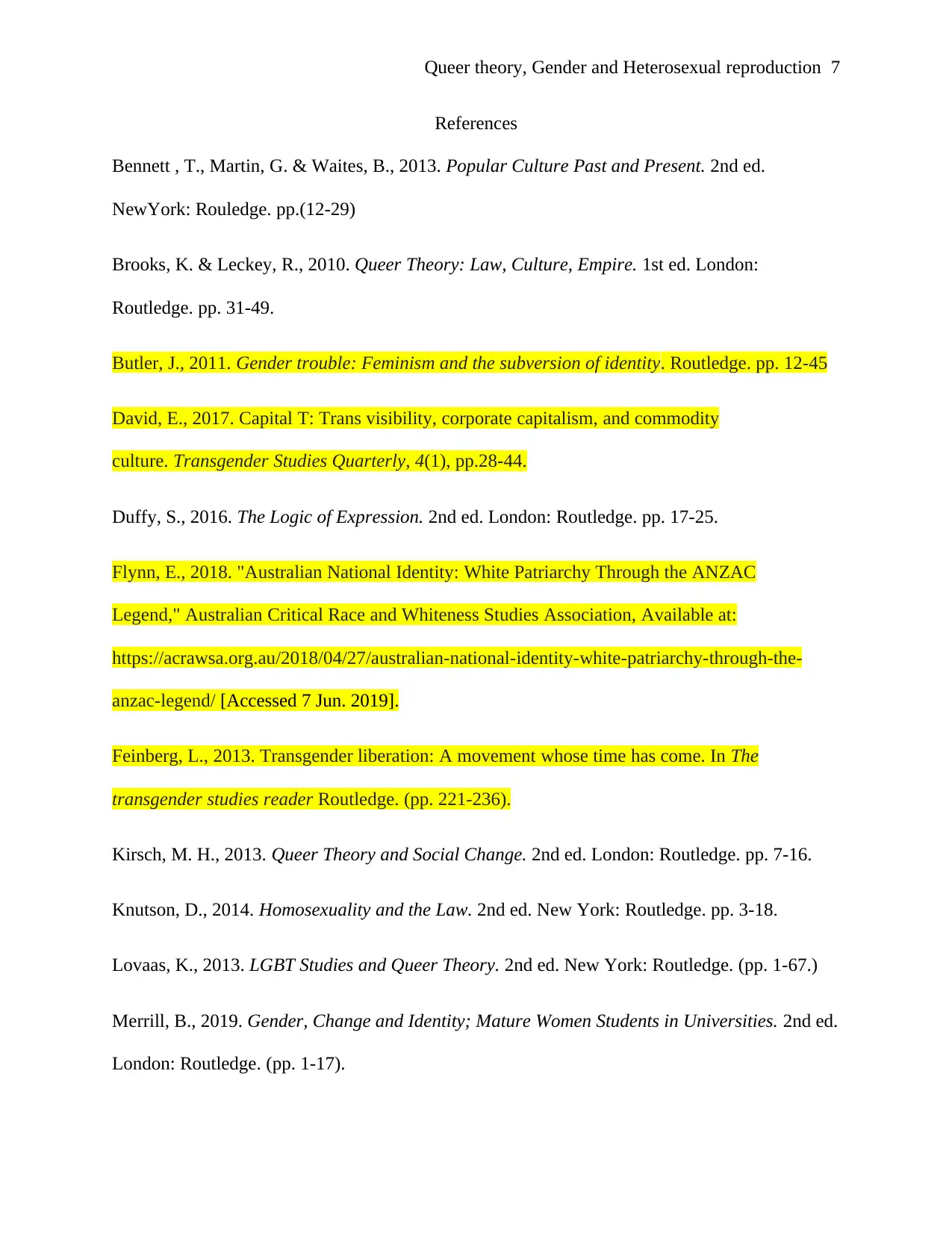
Queer theory, Gender and Heterosexual reproduction 7
References
Bennett , T., Martin, G. & Waites, B., 2013. Popular Culture Past and Present. 2nd ed.
NewYork: Rouledge. pp.(12-29)
Brooks, K. & Leckey, R., 2010. Queer Theory: Law, Culture, Empire. 1st ed. London:
Routledge. pp. 31-49.
Butler, J., 2011. Gender trouble: Feminism and the subversion of identity. Routledge. pp. 12-45
David, E., 2017. Capital T: Trans visibility, corporate capitalism, and commodity
culture. Transgender Studies Quarterly, 4(1), pp.28-44.
Duffy, S., 2016. The Logic of Expression. 2nd ed. London: Routledge. pp. 17-25.
Flynn, E., 2018. "Australian National Identity: White Patriarchy Through the ANZAC
Legend," Australian Critical Race and Whiteness Studies Association, Available at:
https://acrawsa.org.au/2018/04/27/australian-national-identity-white-patriarchy-through-the-
anzac-legend/ [Accessed 7 Jun. 2019].
Feinberg, L., 2013. Transgender liberation: A movement whose time has come. In The
transgender studies reader Routledge. (pp. 221-236).
Kirsch, M. H., 2013. Queer Theory and Social Change. 2nd ed. London: Routledge. pp. 7-16.
Knutson, D., 2014. Homosexuality and the Law. 2nd ed. New York: Routledge. pp. 3-18.
Lovaas, K., 2013. LGBT Studies and Queer Theory. 2nd ed. New York: Routledge. (pp. 1-67.)
Merrill, B., 2019. Gender, Change and Identity; Mature Women Students in Universities. 2nd ed.
London: Routledge. (pp. 1-17).
References
Bennett , T., Martin, G. & Waites, B., 2013. Popular Culture Past and Present. 2nd ed.
NewYork: Rouledge. pp.(12-29)
Brooks, K. & Leckey, R., 2010. Queer Theory: Law, Culture, Empire. 1st ed. London:
Routledge. pp. 31-49.
Butler, J., 2011. Gender trouble: Feminism and the subversion of identity. Routledge. pp. 12-45
David, E., 2017. Capital T: Trans visibility, corporate capitalism, and commodity
culture. Transgender Studies Quarterly, 4(1), pp.28-44.
Duffy, S., 2016. The Logic of Expression. 2nd ed. London: Routledge. pp. 17-25.
Flynn, E., 2018. "Australian National Identity: White Patriarchy Through the ANZAC
Legend," Australian Critical Race and Whiteness Studies Association, Available at:
https://acrawsa.org.au/2018/04/27/australian-national-identity-white-patriarchy-through-the-
anzac-legend/ [Accessed 7 Jun. 2019].
Feinberg, L., 2013. Transgender liberation: A movement whose time has come. In The
transgender studies reader Routledge. (pp. 221-236).
Kirsch, M. H., 2013. Queer Theory and Social Change. 2nd ed. London: Routledge. pp. 7-16.
Knutson, D., 2014. Homosexuality and the Law. 2nd ed. New York: Routledge. pp. 3-18.
Lovaas, K., 2013. LGBT Studies and Queer Theory. 2nd ed. New York: Routledge. (pp. 1-67.)
Merrill, B., 2019. Gender, Change and Identity; Mature Women Students in Universities. 2nd ed.
London: Routledge. (pp. 1-17).
Paraphrase This Document
Need a fresh take? Get an instant paraphrase of this document with our AI Paraphraser
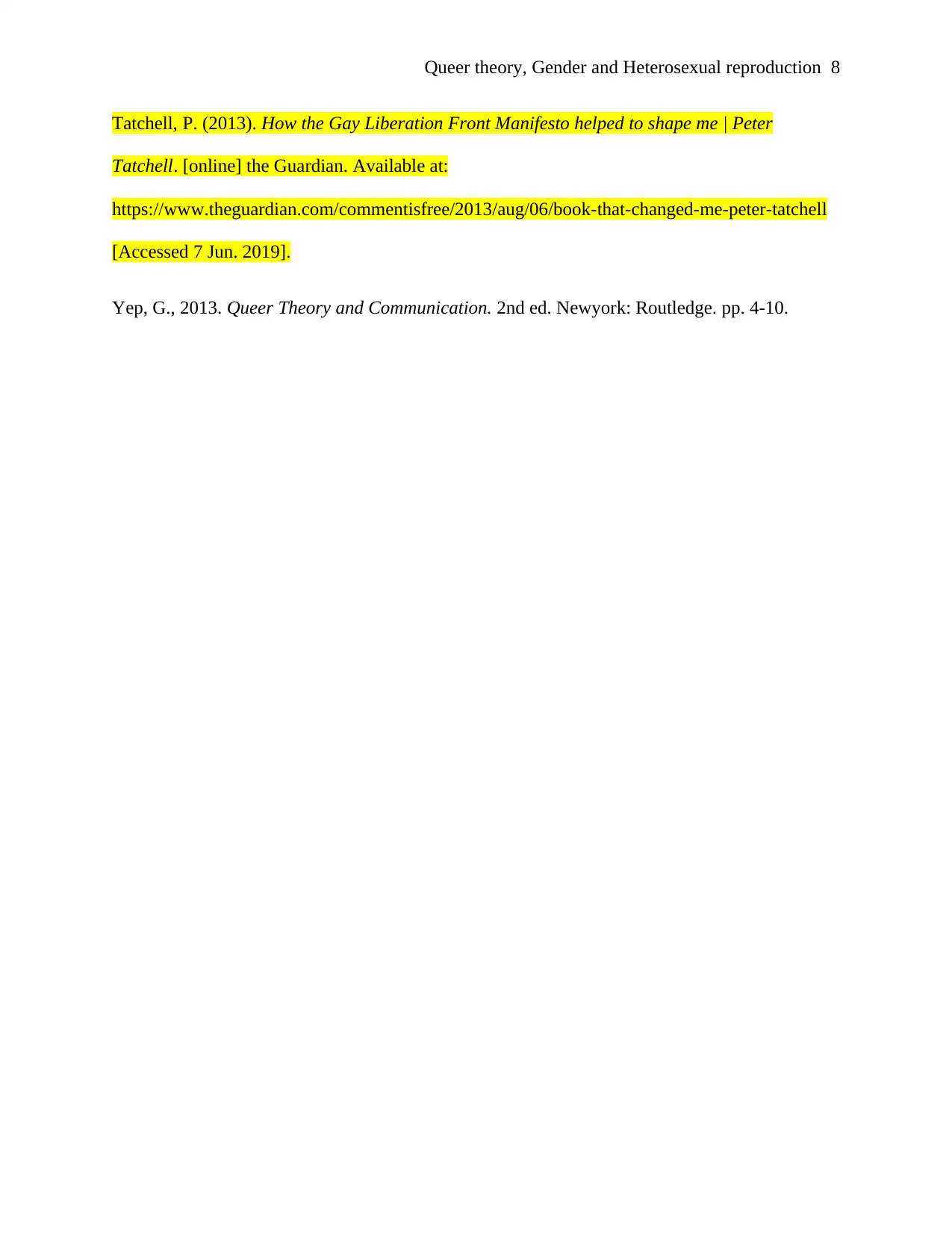
Queer theory, Gender and Heterosexual reproduction 8
Tatchell, P. (2013). How the Gay Liberation Front Manifesto helped to shape me | Peter
Tatchell. [online] the Guardian. Available at:
https://www.theguardian.com/commentisfree/2013/aug/06/book-that-changed-me-peter-tatchell
[Accessed 7 Jun. 2019].
Yep, G., 2013. Queer Theory and Communication. 2nd ed. Newyork: Routledge. pp. 4-10.
Tatchell, P. (2013). How the Gay Liberation Front Manifesto helped to shape me | Peter
Tatchell. [online] the Guardian. Available at:
https://www.theguardian.com/commentisfree/2013/aug/06/book-that-changed-me-peter-tatchell
[Accessed 7 Jun. 2019].
Yep, G., 2013. Queer Theory and Communication. 2nd ed. Newyork: Routledge. pp. 4-10.
1 out of 8
Related Documents
Your All-in-One AI-Powered Toolkit for Academic Success.
+13062052269
info@desklib.com
Available 24*7 on WhatsApp / Email
![[object Object]](/_next/static/media/star-bottom.7253800d.svg)
Unlock your academic potential
Copyright © 2020–2025 A2Z Services. All Rights Reserved. Developed and managed by ZUCOL.





